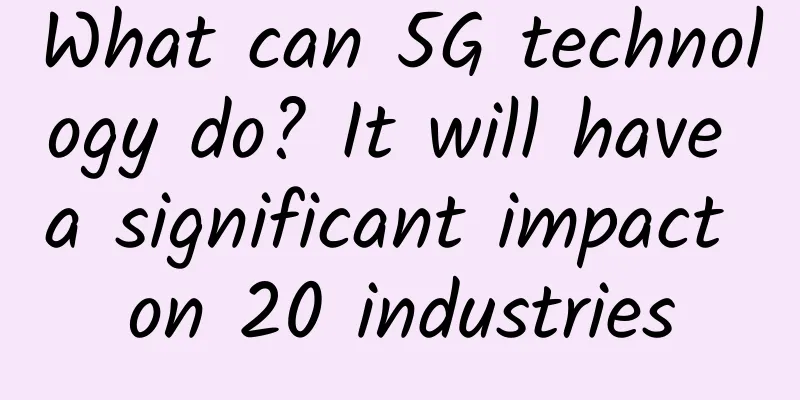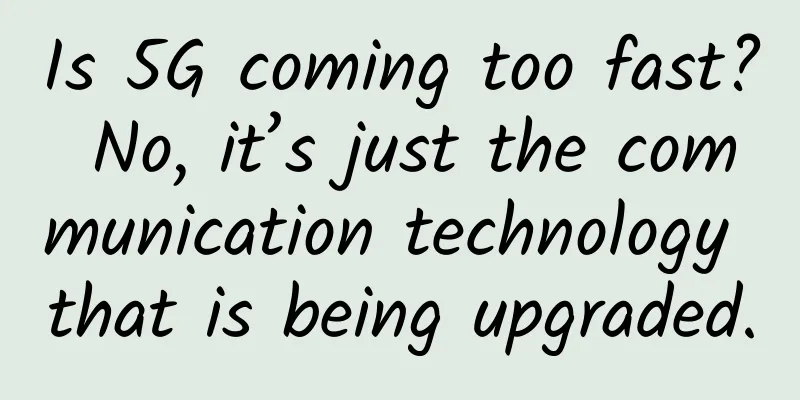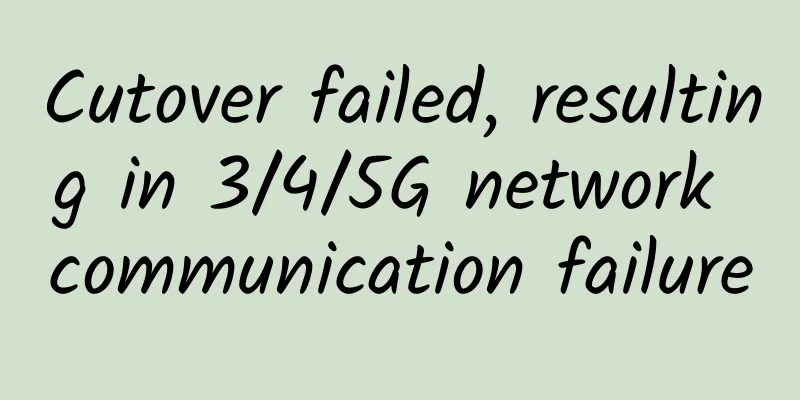What can 5G technology do? It will have a significant impact on 20 industries

|
First of all, we must know what 5G is. In a nutshell, it is a wider coverage network with faster speed and stability. Of course, there are many deeper meanings, which will not be discussed here. However, 5G, a new era product developed in response to the increase in the number of IoT devices and the increase in data volume, affects not only the technology industry, but most of the industries currently seen in the market. From healthcare to financial services to retail, all industries will be impacted by 5G technology.
1. Manufacturing 5G technology can help manufacturing operations become more flexible and efficient, while improving safety and reducing maintenance costs. This will enable manufacturers to use automation, artificial intelligence, AR (Augmented Reality) and the Internet of Things to achieve "smart factories." Remote control, monitoring and reconfiguration through 5G mobile networks can enable machinery and equipment to self-optimize production lines and simplify overall planning. In addition, the next generation of wireless also has the opportunity to improve the application of AR technology in manufacturing, because 5G networks continue to provide enhanced network quality and support the required high bandwidth and low latency. This means that in a factory environment, AR can support training, maintenance, construction and repair. For example, the Ericsson factory in Tallinn, Estonia, uses AR technology for troubleshooting to reduce failure costs and production downtime. The use of AR technology has reportedly increased productivity by 50%. As 5G matures, more manufacturers will use 5G technology. Samsung and AT&T have collaborated to create the nation’s first manufacturing-focused 5G “innovation zone” in Austin, Texas, to test and demonstrate how 5G can impact the manufacturing industry. 2. Energy and Utilities 5G can bring more innovative solutions to the production, transmission, distribution and use of the existing energy industry, and is expected to develop the next wave of smart grids with more powerful functions and efficiency. 5G technology can connect and integrate many unconnected energy-consuming devices at low cost, which will improve grid monitoring and make energy demand forecasts more accurate, making energy management more efficient, thereby reducing power peaks and overall energy costs. In addition, 5G significantly extends the life of battery-related equipment. This makes large-scale deployment of IoT sensors a more practical solution for the energy industry to reduce costs and improve safety. For example, the use of drone monitoring and information transmission in a 5G environment can greatly improve the uptime of the power grid. This alone can reduce costs by 30%. However, 5G devices themselves consume energy. 3. Agriculture Farmers around the world are using IoT technology to optimize overall agricultural production processes such as water management, irrigation and fertilization, livestock safety, and produce monitoring. 5G technology can facilitate the adoption of IoT devices to achieve this goal. 5G can provide farmers with more timely data to monitor, track and automate their agricultural systems to improve profitability, efficiency and safety. In a high-risk industry like agriculture, these increases in yield and precision are critical, especially as climate change threatens to change at any time. However, current technology is not advanced enough to handle the large amount of data and speed required for smart agriculture. This is because the network in rural areas is still largely lacking. For example, according to statistics, about 80% of rural areas in the UK are not included in the scope of 4G services; in the United States, as of 2015, more than half of rural areas have no network services. Therefore, if 5G can be developed smoothly in the future, rural areas may be 4 to 5 years later than urban areas to go online. 4. Retail Shopping using mobile devices is extremely popular around the world. Thanks to 4G/LTE technology, more than 100 million Americans shopped on their smartphones in 2018. Imagine if network speeds were 10 times faster, what would happen to the mobile shopping experience? In addition, 5G technology supports AR/VR applications, so there is an opportunity to launch more VR/AR experiences in physical stores in the retail industry, such as try-on, virtual space, etc. According to consumer shopping habits, the same functions may also be experienced at home. It is estimated that by 2020, global retail display AR/VR application spending is expected to reach approximately US$5.9 billion. 5. Financial Services As financial institutions pay more and more attention to the promotion of mobile devices, 5G technology is expected to be used in one-way and two-way services. 5G greatly improves security and network speed, and can complete transactions on mobile phones faster and more securely than any existing process; the user may be contacted by AI or remote bank staff, both of which can meet the different needs of users. In addition, 5G can allow wearable devices (such as smart watches) to share biometric data with financial services to immediately and accurately verify the user's identity, which is not only safer but also faster to complete transactions. 6. Media and Entertainment 5G will profoundly impact media and entertainment at multiple levels, including mobile media and advertising, home networking, and TV. It will also be critical to improving the experience of new interactive technologies such as AR/VR. Due to the low latency of 5G, online videos are less likely to pause or stop. On a 5G network, movie downloads will be reduced from an average of 7 minutes to just 6 seconds. 5G will save users an average of 23 hours of loading time per month when browsing social media, games, online media music, and downloading movies and programs. In addition, 5G will be able to support user interaction with virtual characters in future AR/VR applications. According to a study conducted by Ovum, the global media industry will be able to generate a staggering $76.5 billion in revenue over the next decade through new services and applications enabled by 5G technology. 7. Healthcare Industry 5G can improve global healthcare in many ways while increasing efficiency and revenue for the healthcare industry. It is estimated that the use of 5G technology in the healthcare sector will create a revenue opportunity of $7.6 billion by 2026. The medical industry can also use the characteristics of high-speed networks to greatly reduce the time it takes to access large amounts of patient data, whether it is personal information, clinical research, or high-resolution MRI and CT image information. 5G will also enable remote monitoring devices (such as wearable technology) to send patient health data to doctors in real time, while also being able to use sensors to understand at any time what kind of space the patient is currently moving in, thereby achieving a more comprehensive and adaptive medical or care approach. 8. Transportation business From buses to taxi fleets, 5G technology has the potential to improve transparency and coordination of transportation systems as networks become more common. In addition to existing transportation, 5G can enhance vehicle-to-vehicle (V2V) communications, which is a key element to improving and adapting to driverless vehicles on the road. V2V communications must be real-time, as milliseconds can be the difference between emergency braking and a fatal collision. Achieving this high-speed interconnection requires vehicles to transmit large amounts of data between each other without any delay. The low latency of 5G networks can achieve this goal. 5G technology can even enable real-time sensing between vehicles and infrastructure, using vehicle-to-infrastructure (V2I) communication to allow vehicles to automatically stop or slow down in response to signals, thereby improving traffic flow, reducing external risk factors, increasing vehicle response time and improving public transportation efficiency. 9. AR/VR The future of augmented reality (AR) and virtual reality (VR) depends on more widespread, reliable, and consistent 5G networks. Of course, the premise is that 5G networks must be mature enough to achieve the primary goal of reducing development costs. AR and VR require a lot of data processing. 5G's latency is reduced by 10 times, traffic and capacity are increased by 100 times, and network efficiency is increased by 100 times, which means 5G can solve these problems. 10. Insurance 5G can help insurance companies make more comprehensive, more effective and more confident decisions because they can obtain more accurate data. With more efficient data sharing, life insurers could make more accurate decisions when providing quotes. As wearable 5G-connected healthcare devices become more common, insurers might be able to offer “positive reinforcement” policies, where consumers receive reduced premiums if they maintain a certain level of activity or health. As 5G ushers in a new era of autonomous and driverless vehicles, real-time data and reports can be sent to auto insurance companies immediately after a customer accident occurs. This will enable insurance companies to investigate and resolve cases more efficiently. 11. Education As 5G paves the way for AR/VR experiences, teachers will be able to use these technologies for a variety of new educational techniques. For example, students can go on virtual field trips around the world, from the Egyptian pyramids to the Great Wall of China, without leaving the classroom. Compared to traditional education methods, AR/VR education platforms offer many benefits, including cost-effectiveness and reduced risk. A study conducted by Next Galaxy Corp and Nicklaus Children's Hospital found that medical staff retained up to 80% of course material after VR training, compared to only 20% after traditional training courses. 12. Cloud Computing The capabilities and features of cloud computing are often downplayed due to low throughput, high latency, and inconsistent connectivity on mobile devices. But 5G networks can increase impact and flexibility. 5G's high throughput and low latency will be able to solve existing problems and take cloud computing to another level. 13. Gaming Industry In a "subscription streaming" society, media such as Netflix and Spotify are very popular among users, and 5G solutions can open up a whole new market for the gaming industry. Currently, the latency of 4G is about 10 milliseconds, while 5G can process it faster, reducing the latency to about 1-2 milliseconds. Faster computing allows users to get a better gaming experience, making quality improvement more cost-effective. Big tech companies have already started to jump into the gaming-as-a-service game scene. Microsoft’s Project XCloud streams Xbox games to PCs, consoles, and mobile devices. Meanwhile, Google has just launched Stadia, a cloud-based streaming game that lets users play games through a Chrome browser, completely disrupting the existing gaming industry. 14. Real Estate Since technologies such as AR/VR will use 5G technology, the real estate industry may be affected. With existing technology, real estate agents have already used 360-degree house viewing services, allowing prospective buyers to view properties they are interested in at home. With the development of 5G, AR/VR may be used in sales centers or real estate agents, allowing consumers to experience walking into the property's space directly in the office, without having to run up and down to different properties in the early stages, thereby improving overall efficiency. But what is worth discussing is that this approach requires the installation of 5G base stations on new objects. Whether such a setup can achieve a balance in terms of health and cost considerations requires further evaluation by real estate developers. 15. Public Safety 5G networks can shorten the time it takes to receive messages and enable broader use of the network to enhance public safety capabilities. Through the 5G network, rescue teams will be able to quickly assist in rescue in the shortest time through real-time images, secure communications or media sharing, and can achieve a higher level of time and location positioning. In addition, 5G networks can achieve information sharing within public safety communities through body monitoring, drones, chat rooms, social media, file sharing and positioning. On the other hand, fingerprint sensors can be used through IoT technology to help identify criminals or victims. In post-disaster situations, 5G-connected drones will be able to provide relief supplies and assist in finding missing persons, which will make public safety more complete. 16. Supply Chain Management Installing 5G sensors on equipment can provide stakeholders with a large amount of real-time data, which may include location, temperature, humidity, pressure or other information, which is critical to the supply chain. Since 5G can extend battery life, 5G sensors will be able to be used for a long time. In addition, the addition of sensors can improve the yield of products. As 5G technology introduces smarter supply chain management, in addition to simplifying logistics processes and reducing costs, there is a certain probability that production will increase. 17. Catering With the development of 5G, the catering industry will be able to increase interaction with consumers and reduce raw material costs. Through 5G IoT devices, it is possible to improve food tracking and understand food waste disposal, so that raw materials can be more finely controlled to reduce costs. On the other hand, consumers can use faster networks to complete orders on their mobile phones, and restaurants can use the extensive 5G network to send drones to deliver more meals to consumers. In addition, kitchen staff can be trained using 5G-connected AR/VR experiences, saving valuable inventory. These 5G applications will be able to effectively reduce costs, improve production efficiency and enhance consumer experience. 18. Tourism There are many governments engaging in tripartite collaboration with tourism operators and technology companies, or tourism operators conducting their own research and development of 5G connection technology to create "smart tourism" to provide tourists with an immersive and improved travel experience. For example, the West of England Combined Authority has already trialed AR/VR experiences for major tourist attractions in Bath and Bristol, with a £5 million award; the BBC, Aardman Animation and the University of Bristol will work on the content and technology development of the project. Tim Bowles, Mayor of the West of England, said: "Imagine a virtual Roman soldier showing you around the Roman Baths and moving in 360 degrees on your phone. This is what 5G technology can provide." 19. Military Communications are key to military strategy. Real-time data collection and transmission of communications network equipment is essential, and 5G technology can maximize data transmission speed. Strengthened communications networks can minimize noise and latency, which can help prevent casualties in war zones. In addition, 5G technology can provide a clearer understanding of spending and resources; using more accurate data collection can help future military budgets. 20. Advertising and Marketing 5G has the potential to transform display advertising into an “immersive experience,” bringing content and audiences closer together. According to Intel research, mobile display advertising is estimated to be a $17.8 billion global market by 2028. 5G can help businesses overcome all the limitations they currently face when handling mobile advertising campaigns. 5G can help marketing and advertising shift from flat ads to moving images and videos; it can even create new advertising formats in VR/AR. 5G can also measure advertising effectiveness in real time through eye tracking and biometric technology, obtain more accurate consumer analysis and conduct research, and reach the most sophisticated consumer audience. |
>>: When porting your number to another network, operators should first change their service mindset
Recommend
IPv4 addresses are exhausted, but the utilization rate of IPv6 addresses in China is only 0.5%
"With the widespread and in-depth applicatio...
The 5G coverage of the three major US operators was accused of false advertising: Verizon can only be connected 9.7% of the time
5G communication networks are reportedly faster t...
Industry Observation | Impact of 5G on the Environment
Investigating the technical, environmental and so...
Wi-Fi Sense: Your home's next sensor may not be a sensor
Part 01 How Wi-Fi Sensing Works Wi-Fi sensing is ...
DesiVPS: Los Angeles 1Gbps unlimited traffic VPS from $18.99 per year, Netherlands VPS from $20 per year
DesiVPS's latest promotion is similar to the ...
Shi Kai: ThoughtWorks creates a competitive advantage for you
[51CTO.com original article] On December 1-2, 201...
2017 Integrated Cabling Industry Analysis Report
1. Overview of the development of the integrated ...
Friendhosting Spring Promotion, VPS at least 45% off for half a year starting from 7.6 euros
Friendhosting is a Bulgarian hosting company esta...
Three ways edge computing expands IoT networks
With 6.4 billion devices connected to the interne...
TCP three-way handshake and four-way wave
TCP (Transmission Control Protocol) is a connecti...
The Ministry of Industry and Information Technology issued a notice on telecommunications service quality: 163 apps have been removed from the shelves, and 158 websites and apps have made aging-friendly modifications, etc.
According to the Ministry of Industry and Informa...
LOCVPS New Year Special: 2GB memory package in Hong Kong/Japan data center starting from 252 yuan/year
LOCVPS (Global Cloud) launched its first promotio...
The fourth largest operator is here and is about to join the battle for 5G users, breaking the three-way competition
As consumers, if we want to receive 5G signals be...
How should we respond to the 5G era? Talking about the prospects and career planning from the perspective of the Internet industry
The 5G war is in full swing, so what are the coun...
As 5G price war begins, US operators also adopt "Internet thinking"
After taking the lead in the world in 5G network ...









